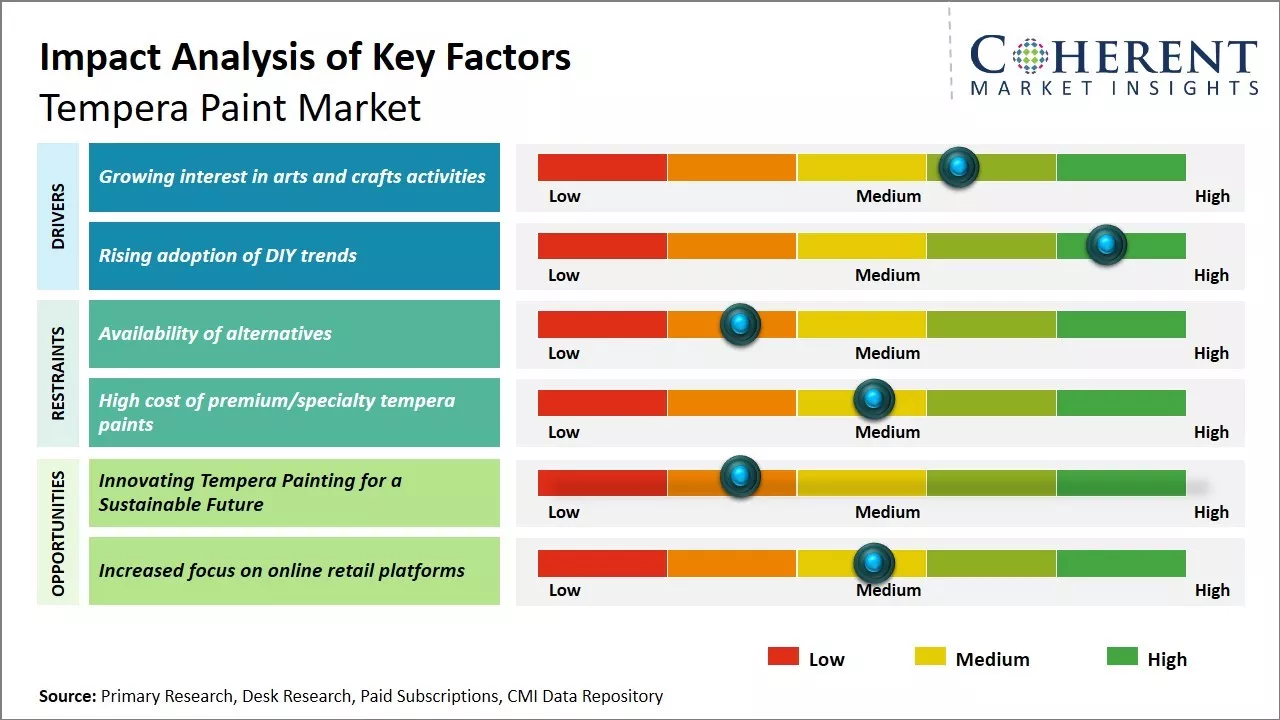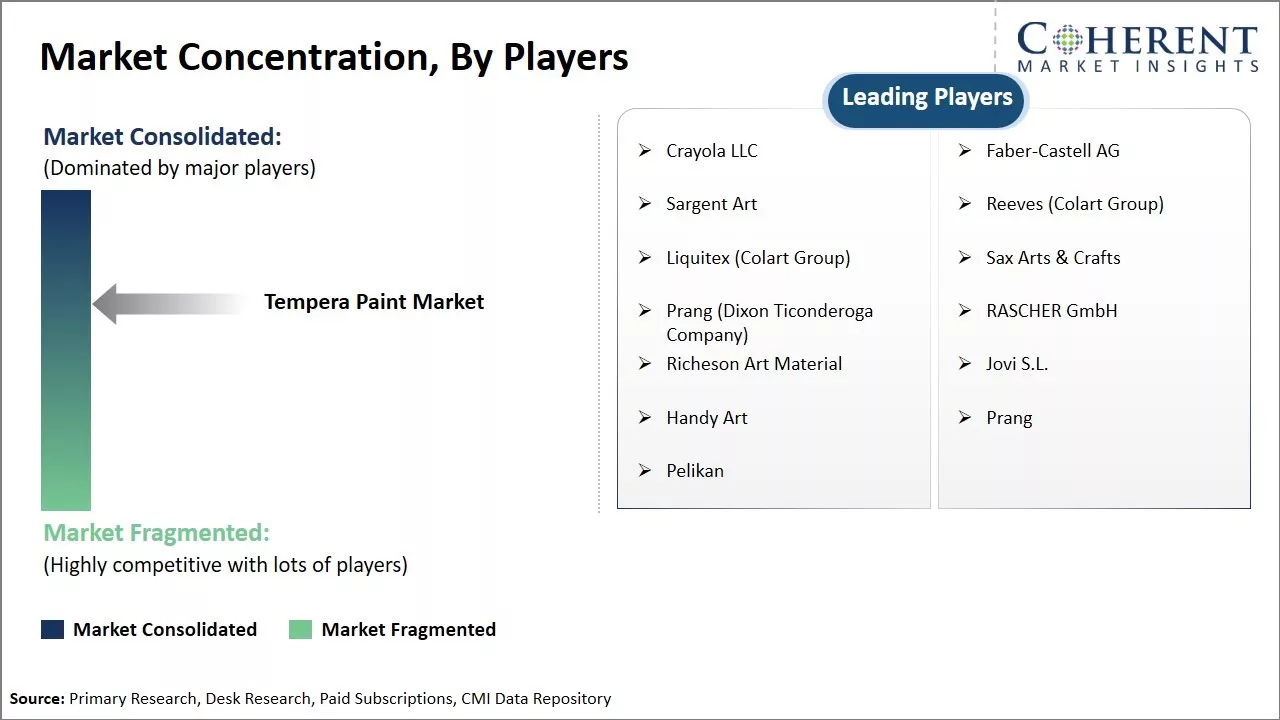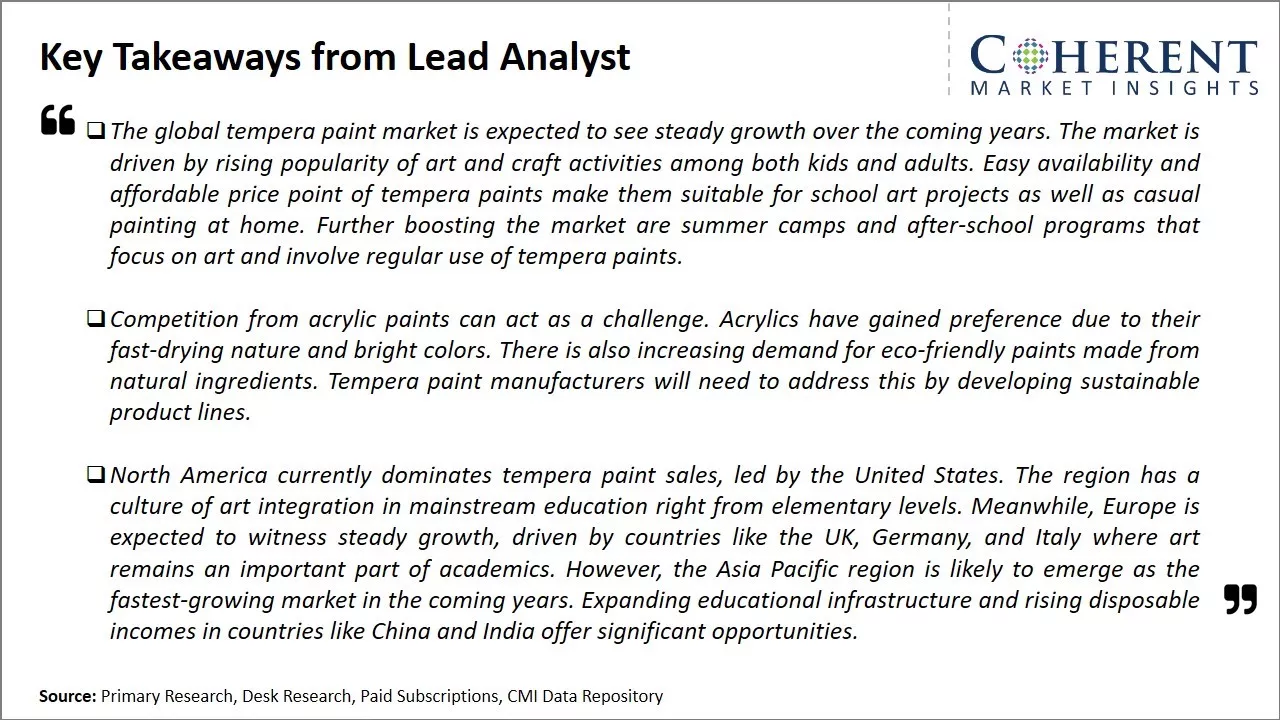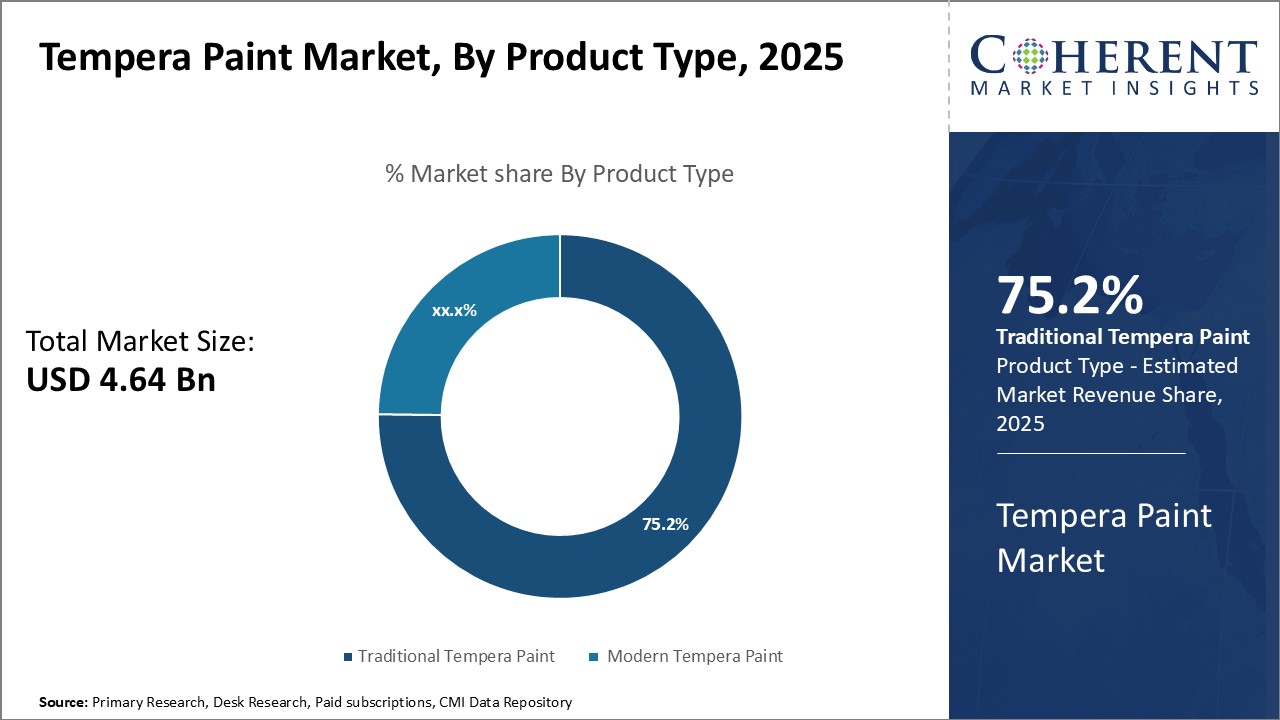Global tempera paint market is estimated to be valued at USD 4.64 Bn in 2025 and is expected to reach USD 6.85 Bn by 2032, exhibiting a compound annual growth rate (CAGR) of 5.7% from 2025 to 2032.

Discover market dynamics shaping the industry: Download Free Sample
Global tempera paint market is expected to witness growth steadily over the forecast period. Rising interest in arts and crafts as a form of stress relief and hobby is driving more people to engage with products like tempera paint. As developing economies prioritize arts in elementary school curriculum, these are adopting tempera paint for classroom art projects, this is further fueling the market growth. However, increasing popularity of acrylic paints poses a threat to tempera paint market growth.
Growing interest in arts and crafts activities
More parents and children have started engaging in arts and crafts like painting, sketching, and coloring during the pandemic. With social distancing norms and lockdowns in place, indoor hobbies became quite popular as these provided enjoyment and relaxation within the safe confines of one's home. Tempera paint is a very commonly used material for arts and crafts projects involving painting as its water-based, non-toxic formulation makes it safe for use by both children and adults. Additionally, tempera paints are inexpensive and easy to procure which has further contributed to their rising popularity. The lockdowns forced families to find constructive ways to spend more time together at home. Arts and crafts using tempera paints emerged as a favorite option. Whether it was painting on canvas, making crafts, decorating cards or gifts, or engaging in other creative projects, tempera paint offered endless possibilities. Even after restrictions eased in many regions, the habit stayed as families enjoyed bonding over artistic pursuits. School closure led to loss of in-person art classes for many young ones, pushing parents to encourage painting and drawing at home using kid-friendly tempera paints. The growing clamor for simple artistic hobbies and activities that anybody can easily take up is expected to keep demand for tempera paints rising steadily.

Get actionable strategies to beat competition: Download Free Sample
Rising adoption of DIY trendsThe DIY or Do-It-Yourself trend has been on an upswing in recent times. More consumers are drawn towards creative, hands-on hobbies that allow them to design and make things from scratch. Be it home decoration projects, gifts for loved ones, or other handmade creations, tempera paints have become a go-to material. DIY trend has increasingly moved from just up cycling to include decorative painting, crafting, and personalization. The convenience of using kid-safe, water-soluble, quick-drying tempera paints encourages many to experiment with DIY projects involved surface decoration and customization. Tempera paints allow colorful, mess-free expression of creativity for decorators of all skill levels. Growing preference for hand-crafted, personalized belongings is expected to boost demand for tempera paints meant for DIY artwork and makerspace projects.

To learn more about this report, Download Free Sample
Market Challenges: Availability of alternativesGlobal tempera paint market faces several challenges. Traditional tempera paint is made from pigments mixed with water and a binder such as egg yolk. However, consumers increasingly prefer alternatives with less messy formulations. Stringent regulations also constrain use of materials like eggs. Rising environmental concerns pose another obstacle as production involves disposal of pigment waste. Finding pigments that maintain vibrancy but use minimal hazardous chemicals presents a hurdle to market growth.
Market Opportunities: Innovating Tempera Painting for a Sustainable Future
There is a demand for modernized versions of tempera paint, making it beneficial to offer experimental kits targeting adults and professionals to attract new users. Collaborating with partners to integrate tempera painting into school curricula and community programs can help broaden awareness. Additionally, the development of eco-friendly pigments using nanotechnology presents an opportunity for industry leaders to showcase sustainability practices.

Discover high revenue pocket segments and roadmap to it: Download Free Sample
Insights, By Product Type: popularity among schools, art institutions, and enthusiasts of classical artistic methods.In terms of product type, traditional tempera paint segment is estimated to contribute the 75.2% share of the market owing to its appeal amongst schools, art institutions and devotees of traditional artistic techniques. Made from the same basic ingredients as when the medium was first formulated hundreds of years ago, traditional tempera maintains the vibrant yet delicate finishes produced by the old masters. Containing pigment suspended in water and an emulsion of egg yolk, traditional tempera paints remain true to the methods used by generations of painters prior to the introduction of modern acrylic and oil based colors. The medium’s connection to history and precedent lends traditional tempera an air of authenticity valued by those seeking to meditate on artistry from eras gone by or instruct students in classical methods.. For hobbyists and casual painters, working with traditional tempera satisfies an interest in experiential learning about artistic heritage. Mixing one’s own colors from raw ingredients and applying them according to age-old practices transports painters back to a time when the discipline required close study of techniques rather than reliance on ready-made commercial products. Appreciation for the craftsmanship behind fine works growing from traditional practices keeps demand strong for traditional tempera among amateur painters as well as professionals devoted to classical art forms.
Insights, By Application: Versatile Applications of Traditional Tempera Paint in Crafts
In terms of application, craft segment is estimated to contribute the 46.9% share of the market. Tempera paint is a versatile medium that finds numerous applications in various forms of crafts. Its water-based nature and ability to adhere to different surfaces make it a popular choice for artists and crafters alike. One common application is in painting on wood, where tempera paint can be used to add vibrant colors and intricate details to wooden crafts such as birdhouses, boxes, or decorative signs. Its ability to dry to a matte finish adds a unique touch to these creations. Additionally, tempera paint is frequently utilized in paper crafts, such as card making, scrapbooking, and paper mache projects. It can be easily applied to paper surfaces to create colorful backgrounds, paint designs, or add accents to enhance the overall visual appeal of the crafts. Its versatility extends to other surfaces as well, including canvas and even glass. Whether used for painting, decorating, or adding artistic touches, tempera paints offer a wide range of possibilities for creative expression in various craft projects.
Insights, By End User: Educational Application Primarily Fuels End User Demand
Among end user, schools and educational institutions segment is estimated to contribute the 41.7% share of the market due to tempera’s effectiveness as a learning medium. Its safety, affordability, and performance properties make tempera especially appropriate for instructing young students in foundational art principles. Non-toxic and with no strong chemical odors, tempera poses little health risk to develop minds. Inexpensive pigments mixed easily with water also keep material costs very low versus other paint types. Its erasability permits students to experiment freely without fear of ruining supplies or work through mistakes. The medium’s layering qualities further lessons on blending colors to form new shades. Tempera’s relative messiness in a playful way introduces motor skills and concepts of form, lines and shapes from an early age. For older students, tempera offers versatility enabling projects exploring diverse styles from realism to abstraction. Professionals in art education have long endorsed tempera as a complete and highly effective training tool, which drives its widespread use among schools. The medium’s pedagogic strengths have made basic tempera paint kits classroom staples, thus educational institutions stay the dominant end user segment.

Need a Different Region or Segment? Download Free Sample
North America has established itself as the dominant region in the global tempera paint market with estaimted4.5% share in 2025. The presence of leading manufacturers along with a well-established art education system has contributed to North America's prominent position. Companies based in the U.S. and Canada have been producing tempera paints for decades and have strong brand recognition among both students and professional artists. Additionally, art programs are widely offered from elementary school through college, ensuring ongoing demand. The preference for American and Canadian brands has also helped North America become a net exporter of tempera paints to other markets.
Asia Pacific has emerged as the fastest growing regional market for tempera paints. Rapid economic development across the region has increased household disposable incomes and education budgets. More students now have access to art instruction compared to prior decades. Growing interest in art and cultural activities also contributes to the rising popularity of visual arts like painting. From a manufacturing perspective, several Asian countries have developed their own tempera paint production capabilities in recent years to satisfy domestic needs. This encourages import substitution and allows local brands to gain market share. As the popularity of tempera painting continues to spread through Asia Pacific, both international and regional suppliers are well-positioned to capitalize on the expanding market.
Tempera Paint Market Report Coverage
| Report Coverage | Details | ||
|---|---|---|---|
| Base Year: | 2024 | Market Size in 2025: | USD 4.64 Bn |
| Historical Data for: | 2020 To 2024 | Forecast Period: | 2025 To 2032 |
| Forecast Period 2025 to 2032 CAGR: | 5.7% | 2032 Value Projection: | USD 6.85 Bn |
| Geographies covered: |
|
||
| Segments covered: |
|
||
| Companies covered: |
Crayola LLC, Faber-Castell AG, Sargent Art, Reeves (Colart Group), Liquitex (Colart Group), Sax Arts & Crafts, Prang (Dixon Ticonderoga Company), RASCHER GmbH, Richeson Art Material, Jovi S.L., Handy Art, Prang, Pelikan |
||
| Growth Drivers: |
|
||
| Restraints & Challenges: |
|
||
Uncover macros and micros vetted on 75+ parameters: Get instant access to report
Share
Share
About Author
Yash Doshi is a Senior Management Consultant. He has 12+ years of experience in conducting research and handling consulting projects across verticals in APAC, EMEA, and the Americas.
He brings strong acumen in helping chemical companies navigate complex challenges and identify growth opportunities. He has deep expertise across the chemicals value chain, including commodity, specialty and fine chemicals, plastics and polymers, and petrochemicals. Yash is a sought-after speaker at industry conferences and contributes to various publications on topics related commodity, specialty and fine chemicals, plastics and polymers, and petrochemicals.
Missing comfort of reading report in your local language? Find your preferred language :
Transform your Strategy with Exclusive Trending Reports :
Frequently Asked Questions
Joining thousands of companies around the world committed to making the Excellent Business Solutions.
View All Our Clients